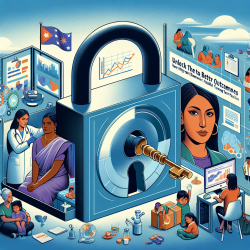As the COVID-19 pandemic forced many therapists to shift their practices online, the use of video and voice calls in psychotherapy became a significant area of study. The research article "Der Einsatz von Sprach- und Videotelefonie in der Psychotherapie als Chance und Herausforderung: Eine Querschnitterhebung zu zwei Erhebungszeitpunkten" provides a comprehensive look at the opportunities and challenges faced by psychotherapists during this transition.
This blog post aims to help practitioners improve their skills by implementing the outcomes of this research or encouraging further investigation into the topic.
Key Findings from the Research
The study conducted by Korunka et al. (2021) involved Austrian psychotherapists and assessed their experiences with video psychotherapy at two different points during the pandemic. Here are some critical insights:
- New Therapeutic Possibilities: Many therapists found that video therapy allowed for greater flexibility in scheduling and location. It also provided unique insights into clients' home environments, which could be therapeutically valuable.
- Challenges and Limitations: Despite the benefits, therapists reported several challenges, such as difficulties with non-verbal communication and technical issues. Specific therapeutic techniques, like body-oriented interventions and creative media, were harder to implement online.
- Client Preferences: The study found that client preferences played a significant role in the success of video therapy. Some clients felt more comfortable and opened up more easily in their home environment, while others missed the in-person connection.
Implementing Research Outcomes
Based on these findings, here are some strategies for practitioners to improve their video therapy sessions:
- Enhance Technical Skills: Familiarize yourself with various video conferencing tools and troubleshoot common technical issues to ensure smooth sessions.
- Adapt Therapeutic Techniques: Modify traditional therapeutic techniques to fit the online format. For example, use digital tools for creative therapies or guide clients through body-oriented exercises they can perform at home.
- Focus on Building Rapport: Pay extra attention to building and maintaining a strong therapeutic relationship. Use verbal affirmations and active listening to compensate for the lack of non-verbal cues.
- Client-Centered Approach: Tailor your approach based on individual client preferences and needs. Some clients may benefit more from video sessions, while others might prefer voice calls or a hybrid model.
Encouraging Further Research
While the study provides valuable insights, there is still much to learn about the long-term effects and best practices for video therapy. Practitioners are encouraged to contribute to this growing body of research by:
- Conducting Case Studies: Document and share your experiences and outcomes with video therapy to help build a broader understanding of its effectiveness.
- Participating in Surveys: Engage in research studies and surveys to provide data on your experiences and challenges with online therapy.
- Collaborating with Peers: Network with other therapists to exchange ideas, strategies, and insights about video therapy practices.
To read the original research paper, please follow this link: Der Einsatz von Sprach- und Videotelefonie in der Psychotherapie als Chance und Herausforderung: Eine Querschnitterhebung zu zwei Erhebungszeitpunkten.










